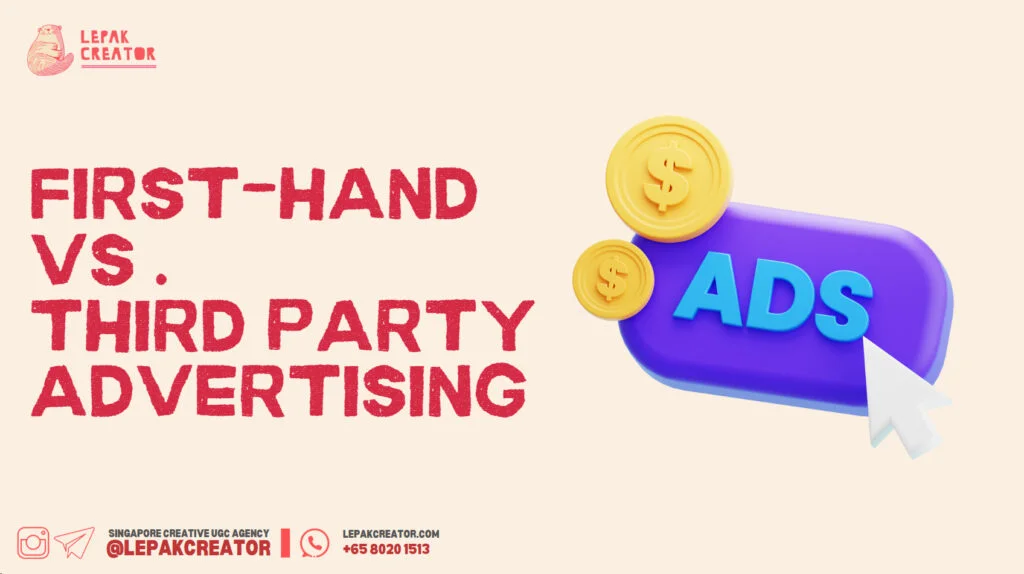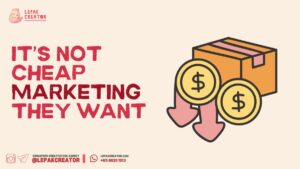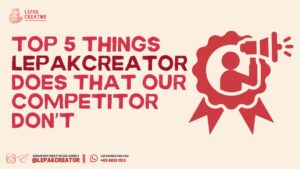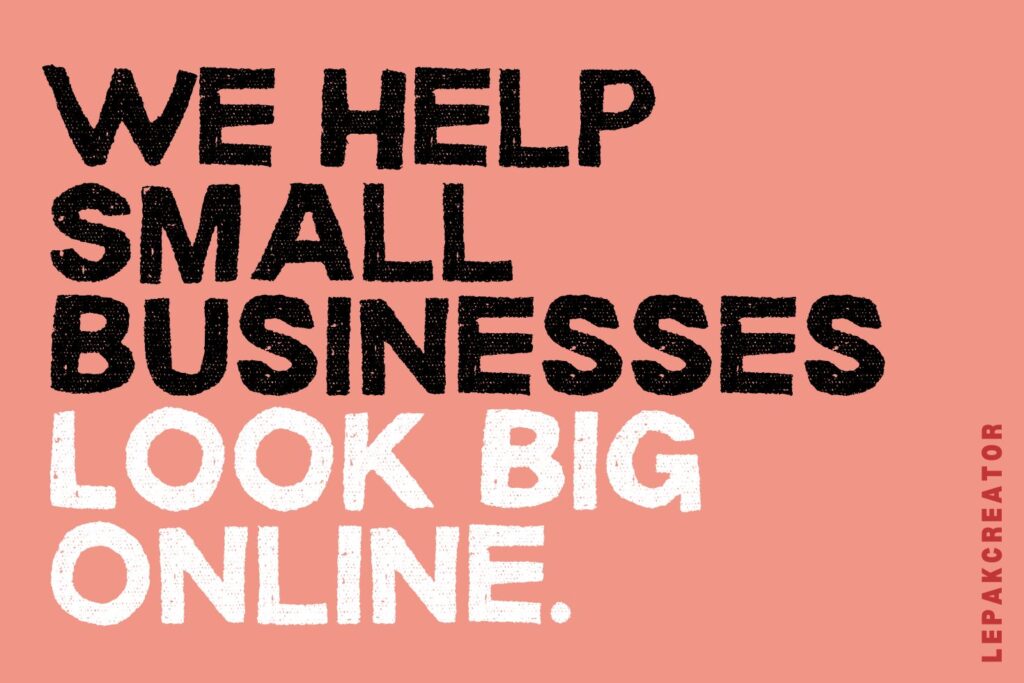When it comes to advertising, businesses in Singapore have a variety of platforms to choose from. Two of the most common categories are first-hand advertising platforms and third-party PR/media advertising platforms. Understanding the difference between the two and how each can help your brand is crucial in crafting a successful advertising strategy.
First-hand Advertising Platforms
First-hand advertising refers to platforms where businesses purchase ad space directly from the provider. These platforms give advertisers full control over their campaigns and offer a wide range of targeting options. Here are some of the most popular first-hand advertising platforms in Singapore:
1. Google Ads
- Ad Options: Search ads, Display ads, YouTube video ads, Shopping ads
- Campaign Objectives:
- Increase brand awareness
- Drive website traffic
- Generate leads or sales

2. Facebook & Instagram Ads
- Ad Options: Photo, Video, Carousel, Stories, Collection ads, Messenger ads
- Campaign Objectives:
- Build brand awareness
- Encourage engagement with posts or ads
- Capture leads through forms
- Drive conversions (purchases, sign-ups)
3. LinkedIn Ads
- Ad Options: Sponsored Content, Text Ads, Message Ads, Dynamic Ads
- Campaign Objectives:
- Generate B2B leads
- Increase brand awareness in professional circles
- Direct traffic to your website or resources
4. TikTok Ads
- Ad Options: In-Feed Ads, Branded Hashtag Challenges, Branded Effects, TopView Ads
- Campaign Objectives:
- Build brand awareness among younger audiences
- Drive user engagement with viral content
- Increase app downloads or sales
5. Spotify Ads
- Ad Options: Audio Ads, Display Ads, Sponsored Playlist, Video Ads (on Spotify Free)
- Campaign Objectives:
- Increase brand visibility
- Encourage listener actions like following a playlist
- Promote events, products, or services
6. Snapchat Ads
- Ad Options: Snap Ads, Story Ads, Filters, Lenses, Collection Ads
- Campaign Objectives:
- Reach younger audiences
- Generate user interactions with creative filters and lenses
- Drive purchases or app installs
7. Twitter Ads
- Ad Options: Promoted Tweets, Trends, Accounts, Video Ads
- Campaign Objectives:
- Increase brand awareness
- Boost engagement with users
- Drive traffic to a website or landing page
- Encourage conversions (e.g., product purchases, sign-ups)
Read more about Benefits of First-hand Advertising Platforms here
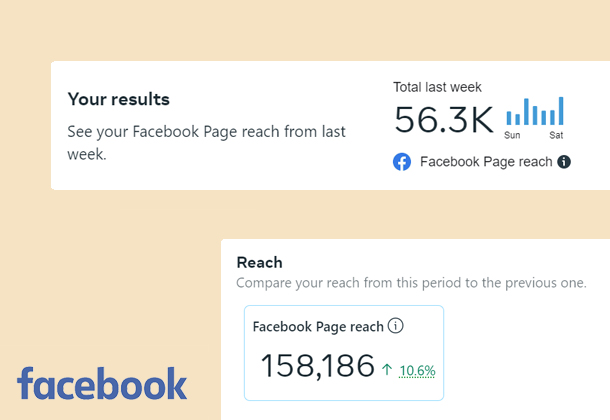
First-hand Advertising Platforms: Price Range and Factors
First-hand advertising platforms are often priced based on models like Cost Per Click (CPC), Cost Per Thousand Impressions (CPM), Cost Per Acquisition (CPA), or flat-rate pricing. Prices can vary significantly depending on your target market, the platform used, and the type of ads you run.
Google Ads
- Cost Model: CPC or CPM
- Average Cost Range:
- CPC: $0.50 to $2.00 per click (depending on industry and competition)
- CPM: $1.00 to $3.00 per thousand impressions
- Maximum Effect:
- Small Business: $500 – $1,000 per month
- Medium Business: $1,000 – $5,000 per month
- Large Enterprise: $10,000+ per month (for national/global campaigns)
Facebook & Instagram Ads
- Cost Model: CPC, CPM, or Cost Per Action (CPA)
- Average Cost Range:
- CPC: $0.20 to $1.00 per click
- CPM: $5.00 to $15.00 per thousand impressions
- Maximum Effect:
- Small Business: $500 – $2,000 per month
- Medium Business: $2,000 – $5,000 per month
- Large Enterprise: $10,000+ per month (for highly targeted campaigns)
LinkedIn Ads
- Cost Model: CPC, CPM, or CPA
- Average Cost Range:
- CPC: $2.00 to $7.00 per click
- CPM: $6.00 to $15.00 per thousand impressions
- Maximum Effect:
- Small Business: $500 – $2,000 per month
- Medium Business: $2,000 – $6,000 per month
- Large Enterprise: $10,000+ per month (B2B or highly targeted campaigns)
TikTok Ads
- Cost Model: CPM, CPC
- Average Cost Range:
- CPC: $0.50 to $2.00 per click
- CPM: $5.00 to $10.00 per thousand impressions
- Maximum Effect:
- Small Business: $500 – $1,500 per month
- Medium Business: $2,000 – $5,000 per month
- Large Enterprise: $10,000+ per month (for viral or influencer-driven campaigns)
Spotify Ads
- Cost Model: CPM or Cost Per Listen (CPL)
- Average Cost Range:
- CPL: $0.02 to $0.08 per listen
- CPM: $5.00 to $10.00 per thousand impressions
- Maximum Effect:
- Small Business: $500 – $2,000 per month
- Medium Business: $2,000 – $5,000 per month
- Large Enterprise: $10,000+ per month (for broader, music-related campaigns)
Snapchat Ads
- Cost Model: CPC, CPM, or CPA
- Average Cost Range:
- CPC: $0.10 to $0.50 per click
- CPM: $2.00 to $8.00 per thousand impressions
- Maximum Effect:
- Small Business: $500 – $2,000 per month
- Medium Business: $2,000 – $5,000 per month
- Large Enterprise: $10,000+ per month (for broader campaigns)

Third-party PR/Media Advertising Platforms
On the other hand, third-party PR/media advertising platforms provide a way to get your message out via established media outlets or content distributors. Instead of buying direct ad space, you are paying for placement through content partnerships or media exposure.
How Third-party Advertising Works
Third-party advertising generally involves leveraging the credibility and audience of a trusted outlet or influencer. This can include:
- Sponsored Content: Articles or blog posts that feature your product or service. These are typically written in a more editorial style, making them feel less like ads and more like informative content.
- Native Ads: Ads that blend seamlessly with the platform’s regular content, making them feel more natural.
- Press Releases and PR Campaigns: Announcements that get featured in news outlets, helping to boost brand credibility and visibility without the appearance of a direct advertisement.
- Influencer Partnerships: Collaborating with influencers to create content that integrates your product or service in a natural and organic way.
Benefits of Third-party PR/Media Platforms
- Credibility: Your brand gains trust by being featured in well-established media outlets or by influencers.
- Audience Engagement: Since the content is often less intrusive, audiences may engage with it more positively, leading to better interactions.
- Longer Lifespan: Sponsored content or articles stay online longer than traditional ads, continuously driving traffic and engagement.
- SEO Benefits: Articles or press releases that include backlinks to your site can help improve your search engine rankings.
- Niche Targeting: You can target specific communities, such as lifestyle enthusiasts, tech geeks, or business professionals, through carefully chosen media outlets.

Third-party PR/Media Advertising Platforms: Price Range and Factors
Third-party advertising through PR or media outlets often involves a different pricing structure. Costs here can depend on the outlet’s reputation, the type of content placement, and whether you’re partnering with influencers, news outlets, or niche media platforms.
Sponsored Content or Articles
- Cost Model: Flat fee per article or partnership
- Average Cost Range:
- Small Blog or Niche Website: $100 – $1,000 per article
- Medium-sized Media Outlets: $1,000 – $5,000 per article
- Major News Outlets: $5,000 – $20,000+ per article
- Maximum Effect:
- Small Business: $500 – $2,000 per month (with smaller media outlets)
- Medium Business: $2,000 – $10,000 per month (for more widespread media reach)
- Large Enterprise: $20,000+ per month (for top-tier publications)
Influencer Marketing
- Cost Model: Flat fee or Pay Per Post
- Average Cost Range:
- Micro-Influencers (1k – 100k followers): $50 – $1,000 per post
- Mid-tier Influencers (100k – 1M followers): $1,000 – $10,000 per post
- Top-tier Influencers (1M+ followers): $10,000 – $100,000+ per post
- Maximum Effect:
- Small Business: $500 – $5,000 per month (working with micro or niche influencers)
- Medium Business: $5,000 – $20,000 per month (collaborating with mid-tier influencers)
- Large Enterprise: $20,000 – $100,000+ per month (partnerships with top influencers)
Press Releases
- Cost Model: Flat fee per release
- Average Cost Range:
- Basic Distribution: $1000 – $2,000 per release (for local or niche distribution)
- Premium Distribution: $2,000 – $5,000 per release (for broader reach and major news agencies)
- High-End Press Release Services: $5,000 – $20,000+ per release (for top-tier media outlets)
- Maximum Effect:
- Small Business: $2000 – $3,000 per month
- Medium Business: $3,000 – $10,000 per month
- Large Enterprise: $10,000 – $50,000+ per month (for national/global PR campaigns)
Native Advertising (Content Marketing via Third-party Sites)
- Cost Model: CPC or flat fee for placement
- Average Cost Range:
- Smaller Niche Sites: $500 – $2,000 per placement
- Medium-Size Sites: $2,000 – $10,000 per placement
- Large Media Outlets: $10,000 – $50,000+ per placement
- Maximum Effect:
- Small Business: $500 – $5,000 per month
- Medium Business: $5,000 – $20,000 per month
- Large Enterprise: $20,000+ per month
Key Advantages Over Traditional First-hand Advertising
- Increased Trust: Being featured in reputable publications or by influencers can build trust with potential customers, as the content feels less like a direct advertisement.
- Content Longevity: Sponsored content or influencer posts remain accessible on the web, offering ongoing visibility long after the campaign ends.
- Engagement Opportunities: Audiences are more likely to interact with content that feels informative, valuable, or entertaining, rather than straightforward ads.

Choosing Between First-hand and Third-party Platforms
First-hand platforms offer control over your ad spend, with a direct correlation between budget and results. You can start with a smaller budget and scale up as you see results. The prices vary depending on the platform and the specific campaign type but tend to be more budget-flexible.
Third-party PR/Media platforms generally involve larger upfront costs but offer the benefit of leveraging external credibility and potentially reaching more targeted or niche audiences. While prices can be higher due to the involvement of media outlets or influencers, these platforms can provide lasting benefits through earned media and increased trust.
Each advertising method has its unique strengths, and in many cases, businesses can benefit from using both in tandem. If you need immediate control over targeting, metrics, and scalability, first-hand advertising platforms are a good choice. On the other hand, if you’re looking for credibility and want to leverage the authority of a media outlet or influencer to engage your audience, third-party PR/media platforms offer long-term value and authenticity.
Understanding your specific goals—whether it’s quick sales, long-term brand building, or specific audience targeting—will help you determine which advertising route and budget to pursue for maximum effectiveness.
Ultimately, your choice will depend on your marketing goals, whether it’s brand awareness, lead generation, engagement, or direct sales. Understanding the strengths of each approach can help you create a more robust and effective advertising strategy in Singapore’s competitive digital landscape.
(credits: pexels)

